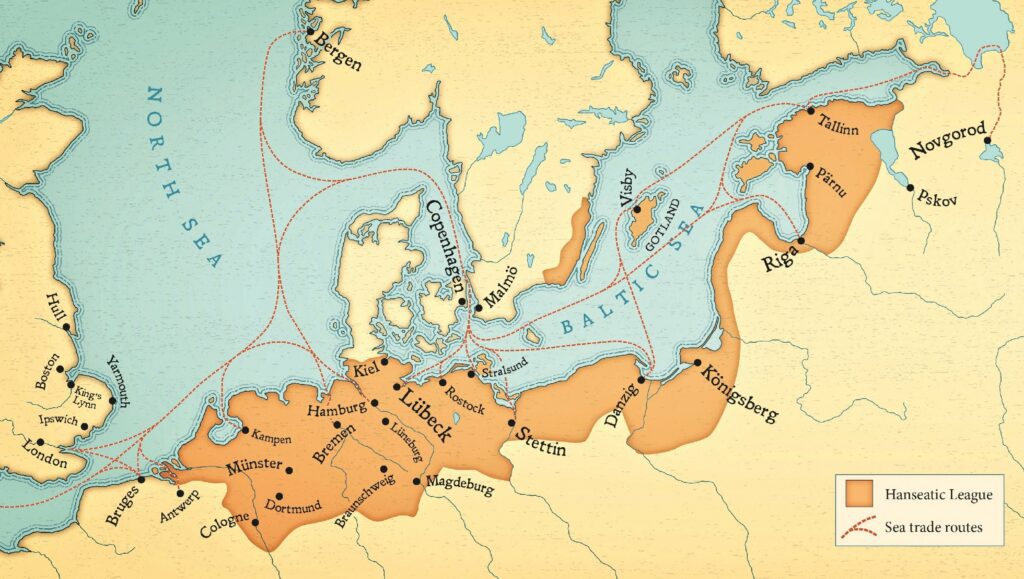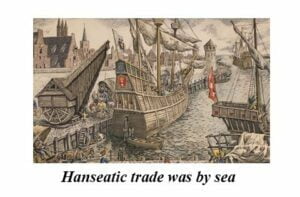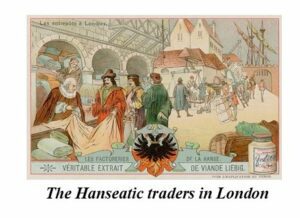
When did it start?
Would you believe that it started as early as the 12th Century when a group of Northern European medieval towns decided to trade between themselves. So, isn’t it interesting that the European Union wasn’t the first time European countries decided that there could be a benefit to all of them if they traded together?
Therefore, a number of north European towns decided to form what was called the Hanseatic League, they created a free trade area some 700 years before the European Union was formed!
It started with just a few towns in north Germany, they were all ports on the Baltic Sea, who realised that if they traded together without taxes, they would all benefit by simply trading between themselves.
It worked, they all benefited economically, they became richer. As others saw that it worked more towns along the coast joined them.  To start with it was coastal towns that became members but then those that were on rivers, along which their ships were trading, joined.
To start with it was coastal towns that became members but then those that were on rivers, along which their ships were trading, joined.
The effect of this was that the league spread over a wide area that extended from Holland to as far as Russia in the east, Estonia in the north and it even reached Poland.
It was set up initially to benefit the commercial interests of the member towns, to:
- protect themselves from piracy and banditry
- develop a duty-free area
- However, most importantly, it was for self-protection
It grew because it worked.
How did it evolve?
Inevitably, as it developed the member cities started to get diplomatic privileges for themselves and their trade routes.
This led to the Hanseatic cities developing a common legal system to govern goods they were selling between themselves. This inevitably led, due to the times they were living in, for them to have to agree to use their armies for mutual defence.
Was this an early version of NATO?
What happened to their economies?
Predictably reducing barriers to trade brought about mutual prosperity, which nurtured economic interdependence, relationships between merchant families, and then, even deeper political integration.
They all benefited, which meant that by the end of the 13th century they had a successful league that slowly became a cohesive political structure.
How powerful was it?
 The benefit of the Hanseatic League was that its members had a virtual monopoly of the trade in both the North and Baltic Seas.
The benefit of the Hanseatic League was that its members had a virtual monopoly of the trade in both the North and Baltic Seas.
Naturally, it expanded, trading with London, then down to Portugal, and finally it reached the Mediterranean, where it traded with cities as far away as Venice.
Hanseatic merchants got a reputation of supplying a variety of commodities and manufactured goods, which gained them privileges and protections abroad. Even in some of these countries they were able to operate almost exclusively under Hanseatic law. As a result of their economic influence, they became a powerful force, even capable of imposing blockades and waging war against kingdoms and principalities.
How was it managed?
Weirdly, it should be remembered that in those days the Hanseatic League was simply a loosely aligned confederation of city-states that were happy to come to mutual agreements. They didn’t have:
- a permanent staff
- a treasury
- a standing army
It was just a group of independent cities that enjoyed thier independence along with the rights and freedoms of their neighbouring cities and they all stuck to the rules!
What happened to it?
Until the 16h Century most of these towns managed their economy themselves and were in effect small city-states, and as such were successful. During that century the larger countries, that operated as single states, England, France, Holland and, of course, Russia started to dominate trade.
Unfortunately, the Leagues freewheeling rules exposed them to these larger economies. This outside pressure slowly wore down the League’s unity, which inevitably led to disputes between the members, which as you could expect inevitably became political. As always happens, these political disputes had a disastrous effect as member states started breaking the League’s fundamental principles.
The end was inevitable and by 1670 the Hanseatic League had unraveled as members slowly left or got gobbled up into other regimes.
Was it a forerunner of the European Community?
Interestingly, the Hanseatic League survived and thrived for more than 300 years under a freewheeling quasi-legislative system that operated by consensus.
Its members were united purely by mutual interest and community, on pooling resources, on raising levies, and harmoniously resolving disputes to further their common goals. This unity, when there was so much political upheaval in Europe, is why many have described it as the most successful trade alliance in history.
 Therefore, was it a more relaxed version of the European Economic Community, which ran for more than 300 years. We now have the EEC, which has just had its 70th birthday, a community with strict rules managed by a huge bureaucracy of administrators.
Therefore, was it a more relaxed version of the European Economic Community, which ran for more than 300 years. We now have the EEC, which has just had its 70th birthday, a community with strict rules managed by a huge bureaucracy of administrators.
It will be interesting to see if it lasts 300 years.
While at the same time it took the second world war to give us NATO. Isn’t it interesting that both these organisations, in a simpler form, were there back in the Middle Ages?
Isn’t History Fun?
10 questions to discuss:
- What were the primary motivations behind the formation of the Hanseatic League in the 12th century?
- How did the Hanseatic League’s initial focus on trade eventually lead to deeper political integration among its member cities?
- In what ways did the Hanseatic League manage to establish a virtual monopoly over trade in the North and Baltic Seas?
- Can you elaborate on the legal and diplomatic privileges that member cities of the Hanseatic League obtained as it evolved?
- How did the absence of a centralized administrative structure impact the management of the Hanseatic League?
- What were some of the external pressures that contributed to the decline of the Hanseatic League in the 16th and 17th centuries?
- Was the Hanseatic League’s dissolution primarily due to economic factors, political disputes among members, or a combination of both?
- Do you see parallels between the Hanseatic League and modern international organizations like the European Economic Community (EEC) or the European Union (EU)?
- What role did economic interdependence play in sustaining the unity of the Hanseatic League over its centuries-long existence?
- In what ways does the historical legacy of the Hanseatic League inform our understanding of contemporary international trade agreements and alliances?
For some more information:
https://www.studysmarter.co.uk/explanations/history/modern-world-history/hanseatic-league/
https://en.wikipedia.org/wiki/Baltic_maritime_trade_(c._1400%E2%80%931800)
https://www.britannica.com/topic/Hanseatic-League/The-League-at-its-outset
© Tony Dalton

